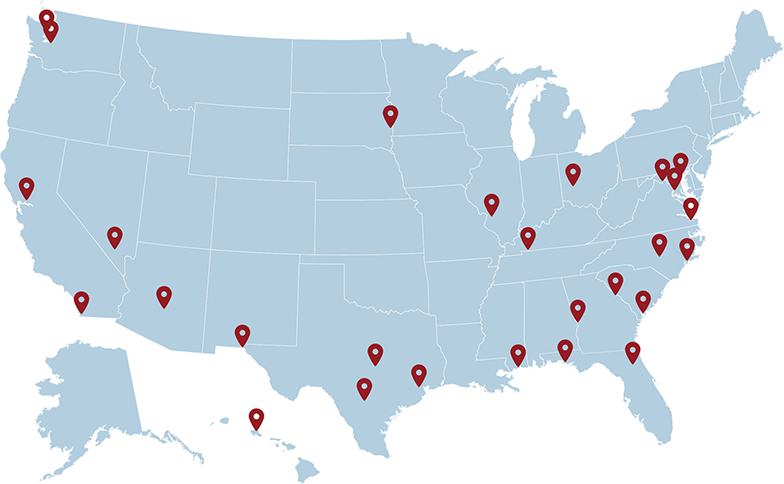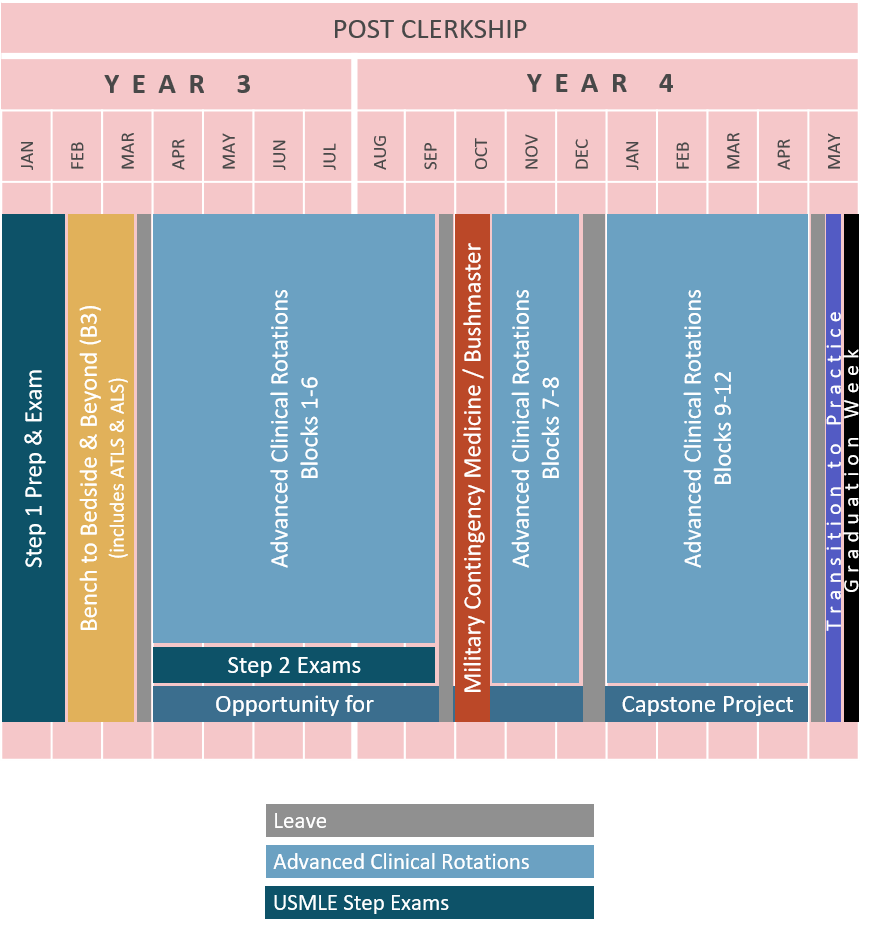
Post Clerkships / Advanced Clerkships
Uniformed Services University of the Health SciencesOPPORTUNITIES AT USU
Our students have the unique opportunity to complete clerkships at military hospitals around the country. From psychiatry with veterans in Hawaii to active duty sailors on ships in Portsmouth, our clerkships provide students unique experiences that span the full spectrum and geography of military medicine. Working in military hospitals all over the country ensures that students get the chance to work with many patient populations in the military health system including veterans, active duty members, and children. Our core clerkships are nested with military residency programs, allowing exposure and networking for residency early in medical training. Not only do our clerkships provide a robust clinical foundation, our students learn clinical medicine while providing care for active duty and retired military members and their families.

LOCATIONS
There are 24 locations for Core Clerkships throughout the United States, and even more choices for Selective and Advanced Clerkship Rotations locations every year.
- Beaumont Army Medical Center
- Bremerton Naval Hospital
- Eglin AFB Hospital
- Fort Belvoir Community Hospital
- Fort Benning Martin Army Community Hospital
- Fort Bragg Womack Army Medical Center
- Fort Gordon Eisenhower Army Medical Center
- Fort Hood Darnall Army Medical Center
- Howard County General Hospital
- Inova Fairfax Hospital
- Keesler Medical Center
- Madigan Army Medical Center
- MedStar Union Memorial Hospital
- Nellis AFB O'Callaghan Military Medical Center
- Naval Hospital Camp Pendleton
- Naval Hospital Jacksonville
- Naval Medical Center Camp Lejeune
- Offutt Air Force Hospital
- Pensacola Naval Hospital
- Portsmouth Naval Medical Center
- Psychiatric Institute of Washington, DC
- San Antonio Military Medical Center
- San Diego Naval Medical Center
- Travis AFB David Grant USAF Medical Center
- Tripler Army Medical Center
- VA Hospital of Washington, DC
- Walter Reed National Military Medical Center
- Wright-Patterson Medical Center
20% hospital locations for Core Clerkships
30+ Selective rotations available
140+ course options for Advanced Clinical Rotations
40+ Advanced Clinical Rotation sites worldwide
TIMELINE
Involvement in clinical clerkships begins in January of Year 2 and continues through the end of a student’s time at USU. Rotations in the core clerkships are completed in three 15-week blocks from January of Year 2 to December of Year 3. Following completion of the core clerkship year, students have a dedicated six-week Step 1 study block. Completion of the Step 1 examination is followed by participation in the “Bench to Bedside and Beyond” phase of the curriculum, which includes training in Advanced Life Support (ALS), Advanced Trauma Life Support (ATLS) and advanced academics focusing on the integration of basic science and clinical medicine. Advanced Clinical Rotations begin in the early spring of Year 3 and end a few weeks before graduation. These are 12 blocks of four-week rotations with three required rotations (Anesthesia, Emergency Medicine, and Neurology). The remainder are student-selected based upon future career plans and are designed in coordination with the guidance from the Office for Student Affairs.
EXPENSES
Core Clerkships: ALL EXPENSES PAID - travel to/from, lodging, and per diem/board if authorized.
Core Selectives: ALL EXPENSES PAID - travel to/from, lodging, and per diem/board if authorized.
Required Subject-Specific Clerkships: ALL EXPENSES PAID - travel to/from, lodging, and per diem/board if authorized.
Required Sub-Internships: NO EXPENSES COVERED
Advanced Selective Clerkships: NO EXPENSES COVERED
One Interview Rotation: All Expenses Paid except rental car
POST-CLERKSHIP/ADVANCED CLERKSHIPS
The post-clerkship period is comprised of twelve 4-week blocks, the majority of which are dedicated to participation in Advanced Clinical Rotations. Included in this time period is a dedicated USMLE Step 1 study period, the Bench to Bedside and Beyond (B3) course, and participation in the advanced Military Contingency Medicine course, which includes involvement in a major field exercise called Operation Bushmaster.
The period of Advanced Clinical Rotations allows time for students to participate In seven four-week elective blocks along with required clerkships in the fields of Anesthesia, Neurology, and Emergency Medicine. In preparation for Internship and Residency, students also complete two Sub-Internships in a specialty of their choosing.

Required Advanced Clerkships
There are three Required Advanced Clerkships. Each has a required Shelf Exam, usually taken at the rotation site on the last day of the rotation.
- Anaesthesia (can be completed during Core Selective, if so: not required, but also not paid in Advanced Clerkships)
- Neurology (can be completed during Core Selective, if so: not required, but also not paid in Advanced Clerkships)
- Emergency Medicine
Required Sub-Internships
Students are required to take two Sub-Internships in any approved specialty that offers a Sub-Internship. Each Sub-Internship must be scheduled and selected in conjunction with a designated advisor within the Office of Student Affairs. No specific specialty selection is required, providing that the experience qualifies as a Sub-Internship.
- General surgery
- Family medicine
- Pediatrics
- Psychiatry
- Internal medicine
- And more
electives
Students have the opportunity to engage in seven* four-week elective blocks of their choosing. Students can use these blocks for additional clinical experiences, civilian or audition rotations, research on a Capstone project, anatomy teaching assistantships, involvement in global health, international or operational medicine rotations, as well as participation in select military schools and programs.
* Students who complete Anesthesia or Neurology during their core selective block will have eight elective blocks in their post-clerkship period.
- Acupuncture
- Addiction Medicine
- Adult Neurology
- Aerospace Medicine
- Allergy
- Anesthesia
- Cardiology
- Child Neurology
- Child Psychiatry
- Dermatology
- Emergency Medicine
- Endocrinology
- General Internal Medicine (Non-Core)
- Gastrointestinal
- Hematology/Oncology
- Infectious Diseases
- Nephrology
- Obstetrics/Gynecology (Subspecialty, Non-Core)
- Operational Medicine
- Ophthalmology
- Pathology
- Pediatrics (Subspecialty, Non-Core)
- Physical Medicine & Rehabilitation
- Pulmonary
- Radiology
- Rheumatology
- Sleep Medicine (Pulmonary)
- Sports Medicine
- Supervised Study Block
- Surgery Elective Subspecialties:
- Ear, Nose, and Throat (ENT)
- Ophthalmology
- Plastic Surgery
- Neurosurgery
- Pediatric Surgery
- Breast Surgery
- Transplant
- Trauma
- Traumatic Brain Injury